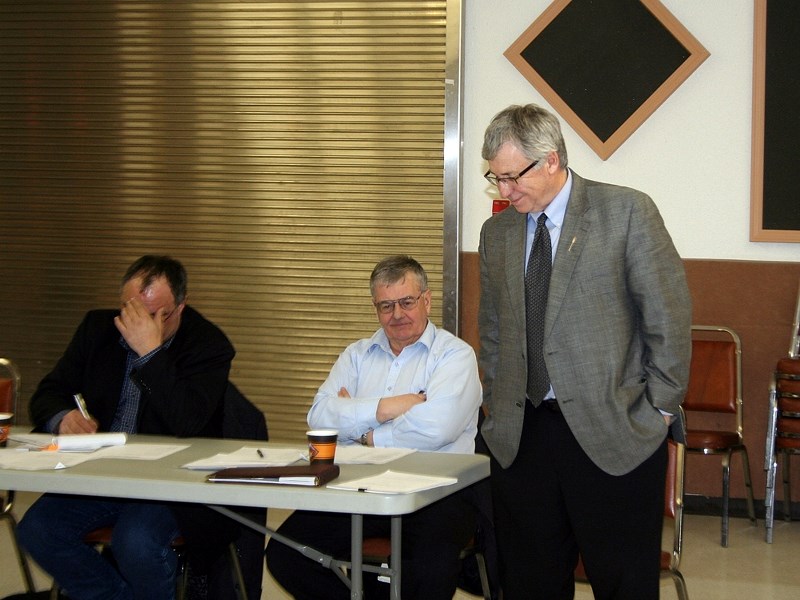While in St. Paul last week, Minister of Environment and Sustainable Resource Development Robin Campbell said the province is continuing to monitor the bitumen leaks at CNRL’s Primrose site, located near Cold Lake. The leaks were first reported in May of 2013.
When asked about the leaks at Primrose, Campbell told the Journal that the province is “regulating and monitoring the situation,” adding, “CNRL has a responsibility to clean up and mitigate the situation, and we’re going to make sure it’s monitored and dealt with, while that goes on.”
Campbell said he and his department are making sure CNRL lives up to the expectations the government has for the company to clean up the area and rectify the situation.
“We have regulations and policies to help us make sure the rules are followed, and the land damages are cleaned up in that area, and all over the province. We work with energy, municipal affairs, each of us has a different aspect that is important for everything to come together.”
Prior to the Lac La Biche-St. Paul-Two Hills Progressive Conservative Association’s annual general meeting on Feb. 6, Campbell also spoke briefly with the Journal about other challenges his department is facing.
“Right now, working on land use frameworks, province-wide is a challenge I’m facing,” said Campbell. He also said that keeping industries in the province responsible when it comes to the impact they are having on the environment has also been a challenge.
“We’re engaging landowners, the industries, and federal government. . . Water is an issue as well, with measures against erosion, and flood recovery in the south. Other things we’re focused on include keeping greenhouse gas emissions down.”
Campbell then presented to the association on a number of issues his ministry is facing, some relating to infrastructure developments and a steadily increasing provincial population.
Danny Smaiel, an association member, asked Campbell about the Highway 63/881 corridor, saying it was a source of frustration for people who use the highways. The highways need to be bigger and more suited to handle traffic in the area, he said.
“If there was an expediting of applications for land, and use of the highway, fewer people would be killed. It’s a challenge. We need to get that corridor improved,” said Smaiel.
In response, Campbell said, “We look at species in the area at risk, like migratory birds and caribou, and that cuts in on our building season. That cuts in on the time the construction can take place, and then the cost goes up because of the building delays.”
He added, “Where do you draw the line between someone’s life and the lives of caribou and birds? The money is there to get that improved, but the MPs need to put it through.”
Another problem Campbell discussed was urban sprawl. With Alberta’s second biggest industry being agriculture, there is a need to protect the land, and he said one of his biggest objectives is to, “redensify urban centres and cut back on sprawl.”
“I drive around to the airport about two times a week and see urban sprawl all over the Leduc-Beaumont area. Some of the best black land in the province is going under pavement.”
The minister said Alberta’s population is growing at an annual rate of 100,000 people, or “at the size of one Red Deer a year.”
A challenge faced by the Department of Environment and Sustainable Resource Development, according to Campbell, is the competing interests of industry and the environment.
Campbell also discussed the necessity of making St. Paul a business centre for northeast Alberta saying, “You’re right next to the pipeline, why can’t St. Paul be a hub for businesses? The infrastructure is in place, and we need to attract foreign people into the area. What better a place to raise a family?”
The minister said he has been working with his department on how to deal with the issue of landfills reaching capacity across the province, admitting, “We know that we have that issue with landfills . . . Suburbs are creeping up all around and people don’t want to live near landfills.”
Campbell suggested one way to cope with the growing load to landfills would be to incinerate garbage.
“If we can look at (co-generation), plans to burn garbage, that would help with our growing infrastructure. Landfills are going to have to be reclaimed, and co-gen might help to reclaim that land,” said Campbell. “There are lots of opportunities in the landscape to reclaim, and lessen the real pressures on the land.”
Later in the meeting, association member Ron Rudkowsky asked the minister to clarify what kinds of burning emission controls would be in place in the case of co-generation, when dealing with garbage.
Campbell said the province would monitor emissions closely if the technology were to be implemented. He said there would be work done with stakeholders and added that cleaning up landfills could offset the problem of emission damage from co-generation.



